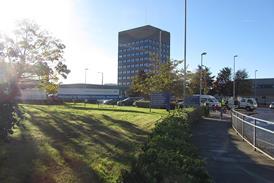In the five year forward view, NHS leaders do not set out a ‘blueprint’ for the service’s future but a series of scenarios it should follow to remain sustainable
In setting out their vision for the future of the NHS over the next five years, NHS England chief executive Simon Stevens and his fellow system leaders take aim at a seminal figure in NHS history. No, not Nye Bevan or Ken Clarke – but Enoch Powell.
HSJ’s forward view coverage
- Unprecedented call for NHS funding growth
- ‘New care models’ to cover half of England
- Health economies to face ‘special measures’ style regime
- Small hospitals could be paid more under forward view plans
- Burnham: ‘I hear the call’ for more cash
- NHS leaders cautious on extension of better care fund
- NHS plans ‘radical upgrade’ in public health
- Major selloff of unused land mooted
- Expanded roles envisaged for non-medical staff
- NHS England to review ‘improvement architecture’
It was Mr Powell’s 1962 Hospital Plan for England and Wales which The NHS Five Year Forward View describes as the “last major blueprint” to set out the idea “that a single new model of care should apply everywhere”. The 1962 plan saw the district general hospital as the central pillar of British healthcare and in doing so created the frame in which three generations of policymakers have wrestled with the NHS’s future.
The 2014 vision seeks to achieve a definitive break with that legacy. It presents not a “blueprint”, but a series of “scenarios” that the NHS could and should follow if it is to meet public demand and remain affordable.
The forward view’s pithiest, truest and most welcome statement is: “There is no ‘right’ answer” as to how the NHS is organised, “but there is a wrong answer, and that is to keep changing your mind. Instead, the default assumption should be that changes in local organisational configurations should arise only from local work.”
A challenge to politicians
Whether the NHS, the public and politicians can cope with this level of permissiveness will, of course, be another matter. Andrew Lansley’s experience would tell you they may struggle.
‘Almost everything would have to go right on the efficiency front for the gap to be closed’
The forward view’s uniqueness also lies in the fact it is the NHS setting out a future and challenging politicians to adopt it or suggest viable alternatives. Reactions, to date, suggest a rush from all the major parties to claim its proposals as cousin to their own visions.
Money, of course, is the major challenge to politicians – and the sum asked for is awkward for all parties, whose existing promises are nowhere near the target set.
However, where the forward view’s funding predictions differ from those in NHS England’s 2013 “call to action” document is that its ambitious efficiency targets have at least closed the gap to a size that politicians can engage with – if not meet fully.
Of course, those required to make those efficiencies may well be justified in raising an eyebrow at the higher number, given that some of those proposing it have relatively recently urged trusts to be more realistic in setting their efficiency aspirations.
One thing is very clear. Even in the unlikely event the politicians can find the money requested, almost everything would have to go right on the efficiency front for the gap to be closed.
Lack of competition
The document’s section on use of technology perhaps best illuminates the efficiency challenge.
It states, counterintuitively for many, “our spending on health related IT…is now broadly at the levels that might be expected looking at comparable industries and countries”.
‘The word “competition” does not appear once in the 39 page document’
This investment has not always delivered the return it should because care models and working cultures have not been ready for the technology to be introduced. It is here where some of any transitional funding that may be secured would be spent. The document appears to signal the broad agreement, for first time, between system leaders on what the technology challenge is. This is significant – and gives hope for a joined up approach to efficiency savings in general.
The fact that the word “competition” does not appear once in the 39 page document is being hailed by a victory by Labour.
The emphasis has shifted from competition to the New Labour mantra of plurality – choice in the market, not competition for the market.
Building Stevenstown
What is different from the last time Mr Stevens exercised a similar influence as today, as Tony Blair’s senior adviser, is that challenge to incumbent NHS trusts is conceived as coming not from independent sector treatment centres, but from scaled up primary care providers like Birmingham’s Vitality Partnership or London’s Hurley Group. The lever to drive that plurality is not, now, the blunt instrument of payment by results, or indeed any qualified provider, but the more sophisticated – and complicated – idea of “integrated personal commissioning”.
‘Perhaps the most intriguing idea, if not the most immediately significant included in the forward view, is health and care “new towns”’
The focus on integrated providers with capitated budgets might suggest a less central role for clinical commissioning groups. Not so, says Mr Stevens.
However, we may be approaching a world in which the emphasis for clinical commissioning groups shifts firmly towards planning and strategy, and away from short term micromanagement of contracts or providers. It may also be a world in which GP leaders see more fulfillment in leading a multispecialty community provider.
Perhaps the most intriguing idea, if not the most immediately significant included in the forward view, is health and care “new towns” – or Stevenstowns as they will surely become known. These new communities being built in areas of high population growth like the Thames Gateway give the NHS a chance to start with a blank sheet of paper and create a healthcare system which, for example, relies much more on technology from the outset, and does not have to struggle with the legacy costs of outdated models. They will make real what the vision encapsulated within the forward view can deliver.
Forward view: Unprecedented call for NHS funding growth
- 1
- 2
 Currently reading
Currently readingThe future begins in Stevenstown
- 3
- 4
- 5
- 6
- 7
- 8
- 9
- 10
- 11
- 12






































7 Readers' comments